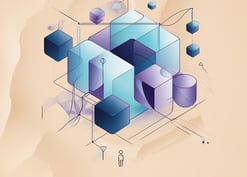How To Hack Your Everyday Decisions with Behavioural Economics
Behavioural economics is less about flawless decisions and more about outsmarting your brain’s quirks. Here’s how to nudge yourself into smarter choices.


Ever wonder why you keep making choices that don’t always serve your best interests? Like why those designer sneakers somehow end up in your cart again or why your gym membership is gathering dust? Welcome to the world of behavioural economics—the perfect blend of psychology and economics that explains why our brains occasionally steer us in odd directions. But here’s the good news: understanding these quirks means we can outsmart them and make better decisions without feeling like we’re fighting an uphill battle. Ready for some mind hacks? Let’s dive in. 🧠💡
1. The Eternal Battle: Now vs. Later (Why Netflix Always Wins)
Ever tell yourself, “Just one more episode” while a looming deadline whispers from the corner of your mind? That’s present bias at work, and it’s all too familiar. We gravitate toward immediate rewards (like the dopamine hit from Netflix) and conveniently shove future consequences (like that project deadline) into a distant corner. This bias is particularly sticky when it comes to finances, where the pull of short-term spending tends to eclipse long-term goals.
Enter Richard Thaler and Shlomo Benartzi’s Save More Tomorrow programme, which is genius in its simplicity. The idea is to commit future-you to save more later— when that pay raise hits—rather than asking today-you to give up your avocado toast. You can set up automatic savings transfers or sign up for your employer’s retirement plan that ups your contributions as you go. The brilliance here is that it bypasses present bias entirely by leveraging inertia. For the sophisticated reader, consider this: commitment devices like this one are particularly effective because they rely on status quo bias—we prefer not to change default settings, especially when they benefit us. By designing our choices today to affect future behaviour, we hack the system.
Pro tip: apply this to habits beyond saving. Want to eat healthier? Pre-order meals for the week on Sunday when you’re still feeling virtuous. Future-you will thank you for locking in those decisions.
2. Decision Fatigue: Too Many Choices, Too Little Time
Ever felt brain-drained after scrolling through endless Netflix categories or staring at rows of cereal boxes? Or maybe you’ve stared at the dinner menu too long and ended up just ordering your “usual”? That’s decision fatigue rearing its ugly head. While the notion of unlimited choice sounds liberating, in reality, it depletes cognitive energy, leaving us susceptible to impulsive decisions or, worse, opting out altogether.
Enter choice architecture, the strategic design of options to help us make better decisions. A famous study by Sheena Iyengar demonstrated that consumers presented with fewer choices (six types of jam versus 24) were more likely to make a purchase and feel satisfied with it. When faced with too many choices, our cognitive bandwidth narrows.
For those well-versed in the field, you know this taps into bounded rationality—our brains, while powerful, can only process so much information before they call it quits. One practical takeaway? Consider narrowing down your own options when making decisions. Simplify where possible. When grocery shopping, make a list and stick to it (and for the love of your wallet, don’t shop hungry!). Sounds boring, but trust me—it’s a sanity saver. Or use heuristics. For instance, if you’re buying something like shampoo and don’t want to spend 20 minutes comparing brands, just grab the middle-priced option. Done. You’ll have more brainpower left for the important stuff, like deciding what to binge-watch next (jk. Start working on that project already!).
3. Anchoring: Why That 50% Off Deal Isn’t Always a Steal
You walk into a store, spot a “50% OFF!” sign, and immediately feel like you’re winning the day. That’s anchoring—where the first price you see becomes your reference point, regardless of its real value. We tend to compare everything after that initial number, and retailers know exactly how to exploit it.
But here’s the twist: you can reverse this bias and use it to your advantage. By anchoring yourself to your own knowledge—whether it’s historical prices or a personal spending threshold—you gain leverage. Counter-anchoring is the behavioural science equivalent of putting yourself in the driver’s seat. If you know that sneakers are usually $100 but see them priced at $200, “on sale” for $150, your internal anchor helps you resist that artificially inflated discount. Consider how anchoring effects can subtly influence negotiations, from salary discussions to pricing strategies in business. Be aware of the anchoring tactics others may use on you—and come prepared with your own baseline to counterbalance them.
4. Loss Aversion and Why It Keeps Us Stuck in Bad Jobs (or Relationships)
Imagine you’re holding onto an old, comfy sweater that’s full of holes. It’s not flattering, but you can’t bring yourself to throw it out because it’s familiar. Now, translate that to a job you’ve outgrown, but can’t quit because the idea of losing something—even if it’s bad—feels worse than the potential gain of a new opportunity. That’s loss aversion, one of the most well-documented biases in behavioural economics.
We’re wired to feel the sting of loss much more than the pleasure of gain. In career terms, this means we are often stuck with the status quo, even when the upside of change could be huge. Here’s where prospect theory (thank you, Kahneman and Tversky) comes into play. It’s not just that we fear loss; we also distort the probabilities, overestimating the risk of leaving a job and underestimating the potential benefits of change.
To challenge this, use mental contrasting: instead of focusing on what you might lose, try shifting your mindset to what you stand to gain. New skills? Better pay? A happier you? Weigh the long-term benefits of a career switch against the short-term discomfort of leaving. The grass really might be greener on the other side!
5. Nudging Yourself: The Art of Designing Better Choices
This might be my favourite one—the nudge. You’ve probably heard of nudging, the concept made famous by Thaler and Sunstein, but what’s fascinating is just how subtle and powerful these interventions can be. A nudge doesn’t force a choice; it just makes the better choice more attractive or easier.
For instance, if you want to cut down on screen time, try shifting the location of your phone charger out of your bedroom. You’re less likely to mindlessly scroll through social media at night if it’s inconvenient. Environmental design is all about reducing friction for good choices and adding a little for bad ones. Default settings are one of the most potent nudges out there, especially in high-stakes environments like organ donation or retirement savings. By setting the “best” option as the default, you align automatic behaviour with optimal outcomes. The question then becomes: how can you design your own defaults in everyday life? From setting up automatic calendar blocks for focused work to pre-scheduling digital detoxes, subtle shifts can drastically improve long-term habits. Want to work out more? Put your gym clothes next to your bed. Boom, instant motivation in the morning! Want to eat healthier? Put the fruits and veggies at eye level in the fridge. The less friction in your decisions, the more likely you’ll stick to your goals.
Make Your Brain Work For You (Instead of the Other Way Around)
At its core, behavioural economics isn’t about fixing irrationality—it’s about working with it. We all have cognitive biases, and sometimes, they lead us astray. But by understanding these biases and designing environments that cater to them, we can gently guide ourselves toward better decisions.
So next time you’re caught between Netflix and a deadline, or trying to justify those “50% off” shoes, pause for a second. Your brain’s not broken—it just needs a little nudge in the right direction.






